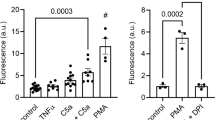Abstract
The effects of fluoride (F) on neutrophil protuberance formation and induced Con A acceptor molecule migration were assessed microscopically. Below 5 mM, F had little effect on acceptor migration, while it markedly inhibited formation of colchicine-induced protuberances. The anion also increased the rate at which preformed protuberances regressed. Since protuberance formation is enhanced by disassembly of microtubules, these data suggest that F promotes and/or stabilizes microtubule assembly. Microtubule assembly is favored by binding of GTP to tubulin subunits, while GDP binding favors disassembly of microtubules. Since F binds with GDP, forming a new complex that mimics GTP, the anion would be expected to enhance microtubule assembly. Over the same F concentration range, the anion failed to inhibit acceptor polarization, but did inhibit cytochalasin B-enhanced dispersion of prepolarized Con A acceptors, implying that, at low concentrations, F also affected microfilament cycling. Concentrations of F in excess of 5 mM inhibited acceptor migration as well as protuberance formation. At 20 mM, the anion abolished both events, yet at this same concentration F induced neutrophil superoxide generation and degranulation, suggesting that acceptor migration is not a prerequisite for these two neutrophil effector activities.
Similar content being viewed by others
References
Bretscher, M. S. 1984. Endocytosis: Relation to capping and cell locomotion.Science 224:681–686.
Loor, F. L. 1974. Binding and redistribution of lectins on lymphocyte membranes.Eur. J. Immunol 4:210–220.
Oliver, J. M., R. Lalchandani, andE. L. Becker. 1977. Actin redistribution during concanavalin A cap formation in rabbit neutrophils.J. Reticuloendothel. Soc. 21:359–364.
Schreiner, G. F., andE. R. Linanue. 1976. Membrane and cytoplasmic changes in B lymphocytes induced by ligand-surface immunoglobulin interaction.Adv. Immunol. 24:37–155.
Walter, R. J., R. D. Berlin, andJ. M. Oliver. 1980. Asymmetric Fc receptor distribution on human PMN oriented in a chernotactic gradient.Nature 286:724–725.
Weinbaum, D. L., J. A. Sullivan, andG. L. Mandell. 1980. Receptors for concanavalin A cluster at the front of polarized neutrophils.Nature 286:725–727.
Hoffstein, S. T. 1981. The role of microtubules and microfilaments in lysosomal enzyme release from polymorphonuclear leukocytes.Methods Cell Biol. 23:259–282.
Goldstein, I., S. T. Hoffstein, J. Gallin, andG. Weissmann. 1973. Mechanism of lysosomal enzyme release from human leukocytes: microtubule assembly and membrane fusion induced by a component of complement.Proc. Natl. Acad. Sci. U.S.A. 70:2916–2920.
Howard, T. H., andW. Meyer. 1984. Chemotactic peptide modulation of actin assembly and locomotion in neutrophils.J. Cell Biol. 98:1265–1271.
Gabler, W. L., H. R. Creamer, andW. W. Bullock. 1986. Modulation of the kinetics of induced neutrophil superoxide generation by fluoride.J. Dent. Res. 65:1159–1165.
Gabler, W. L., H. R.Creamer, and W. W.Bullock. 1983. Fluoride modulation of neutrophil degranulation.Reticuloendothel. Soc. Abstract. 37.
Wilkinson, P. C. 1983. Effects of fluoride on locomotion of human blood leukocytes in vitro.Arch. Oral Biol. 28:415–418.
Curnutte, B. D., B. M. Babion, andM. L. Karnorsky. 1979. Fluoride-mediated activation of the respiratory burst in neutrophils. A reversible process.J. Clin. Invest. 63:637–647.
Gabler, W. L., H. R.Creamer, and W. W.Bullock. 1988. Fluoride activation of neutrophils, similarities to formyl-methionyl-leucyl-phenylalanine.Inflammation (in press).
Bullock, W. W., W. L. Gabler, andH. R. Creamer. 1982. A rapid quantiative assay for activated neutrophils.Inflammation 6:305–318.
DePetris, S. 1974. Inhibition and reversal of capping by cytochalasin B, vinblastine and colchicine.Nature 250:54–56.
Hays, T. S., andE. D. Salman. 1986. The stabilization of microtubules in isolated spindles by tubulin-colchicine complex.Cell Motil. Cytoskel. 6:282–290.
Margolis, R. L., andL. Wilson, 1981. Regulation of microtubule steady state in vitro by ATP,Cell 18:673–679.
Zurier, R. B., S. Hoffstein, andG. Weissmann. 1973. Mechanisms of lysosomal enzyme release from human leukocytes. I. Effects of cyclic nucleotides and colchicine.J. Cell Biol. 58:27–41.
Spilberg, I., B. Mandell, andS. Hoffstein. 1979. A proposed model for chemotactic deactivation. Evidence for microtubule modulation of polymorphonuclear leukocyte chemotaxis.J. Lab. Clin. Med. 94:361–369.
Kirschnen, M., andT. Mitchison. 1986. Beyond self-assembly: From microtubules to morphogenesis.Cell 45:329–342.
Allende, J. E. 1988. GTP-mediated macromolecular interactions: The common features of different systems.FASEB J. 2:2356–2367.
Snyderman, R., C. D. Smith, andM. W. Verghese. 1987. Model for leukocyte regulation by chemoattractant receptors: Roles of a quanine nucleotide regulatory protein and phosphoinositide metabolism.J. Leuko. Biol. 40:785–800.
Howlett, A. C., P. C. Sternweiss, B. A. Macik, P. M. Van Arsdale, andA. G. Gilman. 1979. Reconstruction of catecholamine-sensitive adenylate cyclase.J. Biol. Chem. 254:2287–2295.
Downes, R. W., A. M. Spiegel, M. Singker, S. Reen, andG. D. Aurback. 1980. Fluoride stimulation of adenylate cyclase is dependent on the quanine nucleotide regulatory protein.J. Biol. Chem. 255:949–954.
DePetris, S. 1975. Concanavalin A receptors, immunoglobulins and O-antigen of the lymphocyte surface. Interactions with concanavalin A and cytoplasmic structures.J. Cell Biol. 65:123–146.
Gabler, W. L., andHunter, N. 1987. Inhibition of human neutrophil phagocytosis and intracellular killing of yeast cells by fluoride.Arch. Oral Biol. 32:363–366.
Author information
Authors and Affiliations
Additional information
This research was supported by a grant from the Medical Research Foundation of Oregon
Rights and permissions
About this article
Cite this article
Gabler, W.L., Mugrditchian, M., Creamer, H.R. et al. Effect of fluoride on movement of concanavalin A-acceptor molecules of human neutrophils. Inflammation 13, 317–328 (1989). https://doi.org/10.1007/BF00914398
Issue Date:
DOI: https://doi.org/10.1007/BF00914398




